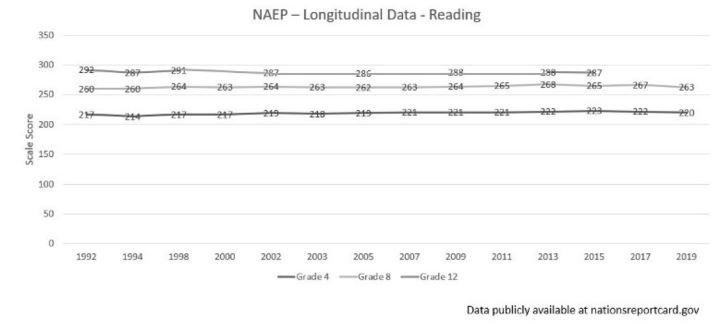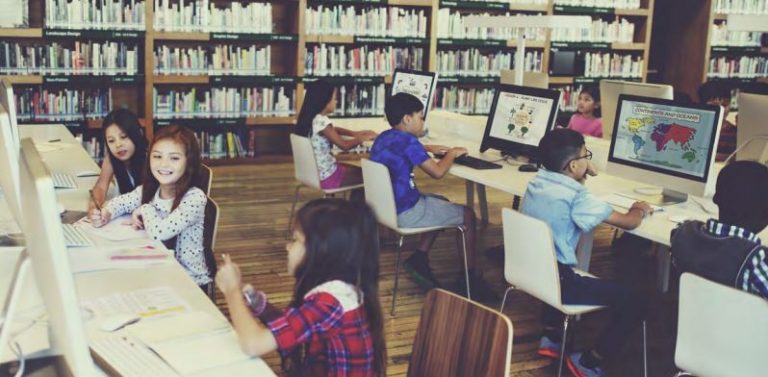By Gene Kerns, originally published in the August, 2021 issue of Equity & Access
In promoting educational equity, our attention is often focused on literacy. This is quite appropriate. As Schmoker (2018) notes, “intensive amounts of reading and writing are the soul of learning” and while “language competency is the foundation of learning.” While we have long understood the primacy of literacy, it’s painfully clear that for many intents and purposes, we do not clearly understand how promote the optimal development of literacy, particularly for students at the greatest disadvantage.
Consider the results from the National Assessment of Education Progress (NAEP). Flatlined scores go back decades and they have remained flat despite the increased accountability of No Child Left Behind, the resulting changes to many school schedules that took time from all areas other than ELA and Math to increase time for these areas, and billions of dollars pumped into early grades reading instruction through Reading First. We have made massive investments, and those investment simply have not produced appreciable returns.

This brings to mind the familiar definition of insanity often attributed to Albert Einstein but actually written by novelist Rita Mae Brown (1983)—doing the same thing over and over and expecting different results. It is very clear that there are problems with our current approach to literacy, an approach that is not addressing equity issues. According to James “Lynn” Woodworth, Commissioner of the National Center for Educational Statistics, if one disaggregates the flatlined overall data, it’s shocking to see that “the bottom is dropping at an alarming rate.”
While scores overall are flat, “students from disadvantaged backgrounds show a characteristic pattern of reading achievement in school; they make good progress until around fourth grade, and then suddenly fall behind” (Willingham, 2017.pg. 128). Daniel Willingham advances that a better understanding of “the importance of background knowledge to comprehension gives us insight into this phenomenon” (2017, p. 128). Pimentel (2018) refers to research in this area as “some of the most profoundly important, yet under-recognized, reading research” available and asserts that “the implications for literacy instruction are enormous.”
While we have always, on some level, acknowledged the role of background knowledge in reading comprehension, we rarely understood the scale of knowledge’s impact. A wave of modern research has clearly documented this connection. A lack of background knowledge can stimy the comprehension of even the most proficient readers, and when background knowledge is controlled for, gaps in reading performance which typically follow socio-economic levels, disappear.
The essential idea is that there are names, dates, places, and concepts that authors automatically assume a reader will generally understand (e.g. “That’s a trojan horse.” “The reacted like Pavlov’s dogs.” “What was your litmus test?” “That was her Waterloo.”) These come from art, music, history, science – so much of the content that we cut to create more time for ELA and math under NCLB.
Consider a recent study done by Adam Tyner and Sarah Kabourek with the Fordham Foundation, viewed by some as one of the most significant pieces of educational research of 2020. Groups of students received additional time in varying ways with the goal of increasing reading proficiency. One group, for example, received more time with reading strategy instruction. Another group received more time with social studies.
Somewhat counterintuitively, reading strategy instruction was found less effective than more content time. The researchers found that “Literacy gains are more likely to materialize when students spend more time learning social studies.” Yet, in a misguided attempt to raise reading scores, we cut time from the social studies in an attempt to raise reading scores.
Hirsch (2018) asserts that “knowledge is by far the most promising avenue to carry us out of the reading slump we are in” and “is by far the most promising way to advance reading skill for all” (p. 31). He adds that schools should come to the realization that “the secret to answering [the complex questions of today’s high-stakes tests] will not be hours of practice of ‘inferencing skills’ and ‘close reading skills,’ but can only be answered through the student’s prior relevant knowledge of the words and the topics” (Hirsch, 2018, p. 30).
In other words, while many students effectively learn the foundational reading skills in the early grades (as attested to by higher proficiency rates at early grade where foundational skills are the focus of those tests), gaps in performance widen quickly in the later grades. This is not because of any reading skills deficiency, but rather a lack of background knowledge. These gaps become apparent when success on later grades tests requires not only foundational reading skills, but also a broad base of general knowledge.
This insight has huge implications for how we address the literacy needs of all students, at risk students in particular. When students appear to struggle with reading, a common approach has been to focus on reading comprehension strategies. While there is a definitive research base on the efficacy of such strategies, what most fail to realize is that these strategies “are quickly learned and don’t require a lot of practice” (Willingham and Lovette, 2014).
Multiple studies have documented that, after a handful of lessons on any strategy, students have received all possible benefit. “Ten sessions yield the same benefit as fifty sessions” meaning that “instruction [on strategies] should be explicit and brief” (Willingham and Lovette, 2014 – emphasis added).
“When it comes to improving reading comprehension, strategy instruction may have an upper limit, but building background knowledge does not; the more students know, the broader the range of texts they can comprehend.” (Willingham and Lovette, 2014 – emphasis added).
The following section from Literacy Reframed speaks to this dynamic through the lens of “The Matthew Effect”:
Addressing the need for knowledge will significantly help teachers address persistent achievement gaps. Many discussions about such gaps reference the Matthew effect. This concept is based on the following Bible verse: “For whosoever hath, to him shall be given, and he shall have more abundance: but whosoever hath not, from him shall be taken away even that he hath” (Matthew [13:12], King James Version). Loosely paraphrased, this verse is familiar to many as the aphorism, “The rich get richer, and the poor get poorer.” When we understand the role of knowledge in comprehension, the Matthew effect applies perfectly: readers with a lot of knowledge become even better readers, and readers who lack knowledge fall further and further behind.
Some students come to school rich in knowledge. Before they could read, they were read to. Once they could read, they were encouraged and supported in doing so. They have visited museums and historical sites, and they have traveled to other cities, other states, or even other countries. Because of the knowledge they have, they take away more from every school lesson, lecture, video, field trip, or other educational experience than their classmates do. As Hirsch (2018) remarks, “The early knowledge base that has been gained by fortunate students is like Velcro; it is a base to which further knowledge sticks more readily” (p. 164). They are rich, and they get richer.
In contrast, other students come to school poor in knowledge. They were seldom, if ever, read to and might not even have a single book. Their home conditions or the responsibilities they bear (such as helping care for younger siblings) are not conducive to wide independent reading, and if they do have the time and inclination to read, they may have few books on hand. They have rarely left their immediate neighborhoods or towns, so their world concept is limited.
As a result, they take away far less from the same educational experiences on which their rich-in-knowledge classmates thrive. They can be sitting in the same classroom, and while the knowledge-rich classmates beside them get richer, they fall further behind.
So, what does mean for us in promoting equity in literacy? It means that we must make knowledge acquisition a top priority. Steps might include the following:
So, what does mean for us in promoting equity in literacy? It means that we must make knowledge acquisition a top priority. Steps might include the following:
- Formally mapping out the names, dates, place, people, and ideas that are part of your curricula – The Core Knowledge Foundation offers a variety of free resources to assist with this.
- Restoring any instructional time cut from social studies and science
- Ensuring that students are read to daily, ideally from materials written about two grade-levels ahead of their tested reading level, which is an idea way to build vocabulary and, if the reading selection is nonfiction, knowledge.
To learn more about the role of knowledge in reading comprehension, consult these resources:
Can reading comprehension be taught? By Willingham and Lovette
Why Knowledge Matters by E. D. Hirsch, Jr.
Literacy Reframed by Robin Fogarty, Gene Kerns, and Brian Pete

The American Consortium for Equity in Education, publisher of the "Equity & Access" journal, celebrates and connects the educators, associations, community partners and industry leaders who are working to solve problems and create a more equitable environment for historically underserved pre K-12 students throughout the United States.
- American Consortium for Equity in Educationhttps://ace-ed.org/author/admin/
- American Consortium for Equity in Educationhttps://ace-ed.org/author/admin/April 23, 2025
- American Consortium for Equity in Educationhttps://ace-ed.org/author/admin/
- American Consortium for Equity in Educationhttps://ace-ed.org/author/admin/







